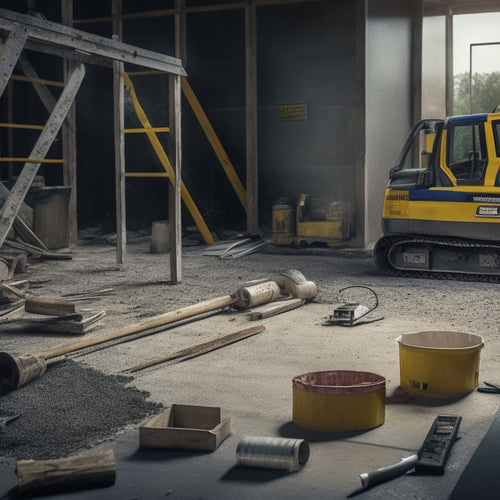
What to Measure for Exterior Wall Renovation Success
Share
To guarantee exterior wall renovation success, you'll need to measure and evaluate five critical aspects. First, measure wall dimensions, noting obstructions, and mark locations for electrical outlets, windows, and doors. Next, assess wall condition and damage, identifying signs of cracking, efflorescence, and water infiltration. You'll also need to inspect for structural integrity issues, such as settlement, shifting, or movement. Additionally, determine material requirements accurately, considering local building codes and environmental impacts. Finally, calculate labor and timeline needs, breaking the project into individual tasks to estimate costs and avoid overruns. As you tackle each of these measurements, you'll uncover the nuances that make or break your renovation project.
Key Takeaways
• Measure wall dimensions accurately, noting obstructions, to ensure proper material quantities and avoid delays.
• Assess wall condition and damage to prioritize repairs or replacements before applying new finishes.
• Identify structural integrity issues, such as settlement or water damage, to address potential concerns.
• Calculate material quantities precisely, considering local building codes and regulations, to prevent budget overruns.
• Estimate labor costs and develop a project schedule to ensure timely completion and avoid overruns.
Measuring and Marking Block Walls
When renovating an exterior wall, you'll need to accurately measure and mark the existing block wall to guarantee a successful installation of new exterior finishes, such as stucco, siding, or brick veneer. To achieve this, you'll require precise measurement tools, including a tape measure, level, and straightedge.
Begin by measuring the wall's length, width, and height, taking note of any obstructions or irregularities. Next, use a level to verify the wall is plumb and level, making adjustments as necessary.
Employ marking techniques such as snapping chalk lines or using a laser level to create a grid pattern on the wall. This will provide a reference point for subsequent measurements and installations.
Additionally, mark the location of any electrical outlets, windows, or doors to verify accurate placement of new finishes. With accurate measurements and markings, you'll be well-prepared to proceed with the installation of your chosen exterior finish, confident in the knowledge that your renovation will be both aesthetically pleasing and structurally sound.
Assessing Wall Condition and Damage
With your measurements and markings in place, you can now inspect the block wall's condition, scrutinizing it for signs of damage, deterioration, or structural weaknesses that may impact the performance of your new exterior finishes.
A thorough wall surface evaluation is essential to identify areas that require repair or replacement before applying new finishes. You'll want to employ damage assessment techniques such as visual inspections, sounding, and probing to detect cracks, voids, and other defects.
| Damage Type | Description | Impact on Finishes |
| Cracking | Hairline cracks or large fractures in the wall surface | Water infiltration, air leaks, and finish delamination |
| Efflorescence | White salt deposits on the wall surface | Aesthetically unpleasing, potential water damage |
| Spalling | Deterioration of the wall surface, causing crumbling or flaking | Reduced structural integrity, increased risk of water damage |
| Staining | Discoloration or staining on the wall surface | Aesthetically unpleasing, potential water damage or structural issues |
Identifying Structural Integrity Issues
You must examine the block wall's structural integrity by checking for signs of settlement, shifting, or other forms of movement that can compromise the wall's ability to support the new exterior finishes. This is essential to guarantee the wall can withstand the added weight and stress of the renovation.
To identify potential structural integrity issues, you should:
-
Conduct crack detection: Inspect the wall for any cracks, fissures, or openings that could indicate movement or settlement. Pay attention to cracks that are wide, deep, or have a zigzag pattern, as these may be indicative of more serious structural issues.
-
Perform a moisture assessment: Check for signs of water damage, staining, or mineral deposits that could indicate water infiltration or high humidity levels. This is important because moisture can compromise the wall's structural integrity over time.
-
Evaluate the wall's foundation and footer: Verify that the wall's foundation and footer are level, plumb, and securely anchored to the surrounding soil. Any deviations from this could indicate settlement or shifting issues.
Determining Material Requirements Accurately
Accurately calculating material quantities is essential to avoiding costly delays and ensuring a successful exterior wall renovation, as even slight miscalculations can lead to project setbacks and budget overruns.
You'll need to determine the exact quantities of materials required for your project, including exterior finishes, insulation, drywall, and framing materials.
Start by taking precise measurements of your exterior walls, accounting for any obstructions, corners, or irregularities.
Next, consult with suppliers and manufacturers to determine the most cost-effective material selection for your project. This will involve evaluating factors such as material properties, durability, and aesthetic appeal.
Be sure to also consider any local building codes, regulations, and environmental concerns that may impact your material choices.
Once you've finalized your material selection, you can proceed with cost estimation, taking into account factors such as material costs, labor costs, and waste allowance.
Calculating Labor and Timeline Needs
Having determined the material requirements for your exterior wall renovation, it's now imperative to calculate the labor and timeline needs to guarantee a seamless execution of the project. You've got the materials nailed down, but without a solid plan for labor and timeline, your project can quickly spiral out of control.
To avoid costly delays and labor overruns, you need to estimate labor costs accurately. This involves breaking down the project into individual tasks, assigning a labor cost to each task, and totaling them up. Additionally, you'll need to develop timeline management strategies to make certain each task is completed on schedule.
Here are three key steps to follow:
-
Create a detailed task list: Break down the project into individual tasks, including preparation, installation, and cleanup.
-
Estimate labor hours and costs: Assign a labor hour estimate and cost to each task, based on your contractor's rate or industry standards.
-
Develop a project schedule: Create a project schedule that outlines the timeline for each task, including start and end dates, and milestones.
Frequently Asked Questions
How Do I Handle Unexpected Renovation Discoveries?
When you uncover hidden damage during exterior wall renovation, don't panic.
You'll need to make budget adjustments to accommodate the unexpected costs.
First, assess the extent of the damage and prioritize repairs.
Then, revisit your budget, identifying areas where you can reallocate funds or cut back on non-essential items.
Be prepared to negotiate with your contractor to find cost-effective solutions.
What Permits Are Required for Exterior Wall Renovations?
When tackling exterior wall renovations, you'll need to secure the necessary permits to avoid costly delays.
You'll typically require a building permit, which covers structural changes, and an electrical permit if you're updating wiring or outlets.
Additionally, plumbing and HVAC permits may be necessary if you're modifying those systems.
Be sure to factor permit acquisition into your renovation timelines, as approval processes can take weeks or even months, depending on your local authorities' workload.
Can I Renovate Exterior Walls in Extreme Weather?
Facing ferocious frost or sweltering summer sun, you're wise to weigh weather considerations before renovating exterior walls.
Don't get derailed by drastic temperature drops or intense UV rays - choose materials that can withstand the elements.
Select durable, weather-resistant materials that fit your climate, and guarantee proper installation to prevent water intrusion and structural damage.
Should I DIY or Hire a Professional for the Renovation?
When deciding between DIY and hiring a pro for your exterior wall renovation, you'll need to conduct a thorough cost analysis and honest skill assessment.
You're considering taking on the project yourself, but can you really handle the complexity and potential risks?
Be realistic about your abilities and weigh the costs of materials, tools, and potential mistakes against the cost of hiring a professional.
How Do I Minimize Disruption to Daily Household Activities?
When planning your exterior wall renovation, you'll want to minimize disruption to daily household activities.
To accomplish this, you'll need to implement effective scheduling strategies, such as phasing the renovation into smaller sections or working on weekdays when possible.
Additionally, prioritize noise management by scheduling noisy tasks during less busy hours or using sound barriers to reduce disturbance.
Conclusion
You've made it to the final stage of planning your exterior wall renovation.
By now, you've measured and marked block walls, assessed wall condition and damage, identified structural integrity issues, and determined material requirements accurately.
According to the National Association of Home Builders, 80% of renovation projects go over budget due to inaccurate material estimates.
Don't let your project be one of them.
With a thorough plan in place, you'll be well on your way to a successful exterior wall renovation that stays on track and within budget.
Related Posts
-

Top 3 Insurance Options for Home Renovation
When renovating your home, you need specialized insurance coverage to protect your finances from unexpected setbacks ...
-

Why Delay Your Renovation With Poor Tool Management
You're likely unaware that poor tool management is a leading cause of renovation delays, and it's not just about havi...
-

Home Renovation Safety Checklist for Homeowners
As a homeowner initiating a renovation project, you know that safety should be your top priority. Start by establishi...


